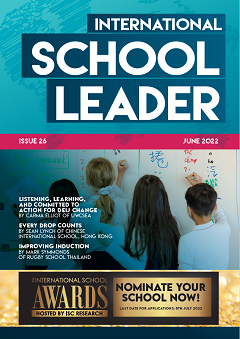By Dr Alan Knobloch
‘Where do we start?’ ‘Talking about racism and discrimination will upset too many people.’ ‘We do not have that problem here.’ ‘How do you get people of colour to apply to your school?’ These are the statements and questions I have heard over the past two years when discussing how to make a school more inclusive. At the International School of Dakar (ISD), we started with a problem.
ISD has over 700 students from 60 different countries. More than half of our students are children of colour. We began our journey in August 2019. Spurred by stories from students about experiencing discrimination, bias, and microaggressions, the board of trustees formed a Diversity and Inclusion Committee with a goal of having all members of the ISD community feel heard, respected, valued, and connected. While the board made important decisions regarding hiring priorities, COVID-19 interrupted our plans. In March 2020, our school went online and the good work started by our board failed to manifest real change while the world struggled to come to terms with the reality of the pandemic.
In late June 2020, frustrated by the lack of action by the ISD administration and motivated by the murder of George Floyd in the United States, a group of alumni, current students, and staff shared their stories of experiencing discrimination, bias, and microaggressions with members of the ISD community through the ‘Black at ISD’ Instagram account. Immediately, our entire community took notice as years of abuse came to light over the summer of 2020.
Where do we start?
The best place to start is by listening and learning. School leaders need to model learning and do the work themselves. I started by attending Anti-Oppression Teaching and Leading in Schools, a workshop by Columbia University. I also read How to Be an Antiracist by Dr Ibram X Kendi. Next, we hired Darnell Fine, a facilitative leader and coach, to offer a series of three workshops. We started with the leadership team, then the board of trustees, and finally the full staff at the start of the school year.
We created a Diversity and Inclusion Team, composed of ISD staff and eventually students. This team is led by Dr Nneka Johnson, our Director of Innovation. The team is responsible for continuing staff professional development and designing the student and staff listening sessions. Dr Johnson and the team is doing amazing work. Her leadership is invaluable and she was named ISD’s first Diversity and Inclusion Coordinator.
The listening sessions were a key first step in making concrete changes. These sessions followed a set protocol facilitated by trusted faculty members, including a school counsellor, which was designed to create a safe space for students and staff to share their stories. Leadership was not present for the listening sessions, which were emotional and painful. They gave us a better picture of the experiences of our community members and we had a better idea of what the issues were so we could address them.
Talking about discrimination will upset too many people
Some schools have avoided starting conversations about diversity and inclusion because members of the administration or the board are afraid it will hurt the school’s image or upset people. The first priority for school leaders is to keep their students and staff safe. If discrimination, bias, and microaggressions are present in your community, your students and staff are being hurt. Leaders have a duty of care. Leaders need to learn how people are being hurt and how to keep them safe.
If you do not feel you can make this a school-wide initiative right away, talk to the students. Who do the students talk to, who do they trust? Ask that person to ask individual students whether they feel respected and valued. Have they experienced discrimination or bias? Start keeping notes, but remove any identifying information about the students to protect them from any backlash. If you get solid data that there are issues, use this to move forward.
We do not have that problem here
Through our student and staff listening sessions, we learned that the issues were not limited to race or ethnicity. Community members also shared concerns related to gender, neurodiversity, sexuality, and gender identity. Support staff expressed concerns with compensation and a lack of professional growth opportunities.
How do school leaders know if there are problems if they don’t ask? School leadership teams are often the last groups to learn of issues of discrimination and under-representation if they rely on the normal channels of communication.
Major accreditation agencies have updated their standards, stating clearly that schools must make progress on creating an inclusive environment for stakeholders. It is better for a school’s leadership to determine if there is a problem rather than waiting for it to surface during the accreditation process.
How do you get people of colour to apply to your school?
First, you need to be a school that is welcoming to a diverse faculty. We have a line in our position advertisements stating that we want a faculty that mirrors the diversity of our students. We are public about our diversity and inclusion work and have a link on our website’s homepage to our action plan.
Next, we actively search for new hires and do not rely only on those who apply to us. We reach out to BIPOC educators and invite them to apply.
Our school actively participates in organisations such as the Association of International Educators and Leaders of Color (AIELOC) and the Diversity Collaborative in order to network and share our story.
In the past two years, 40% of our new teachers are people of colour.
Moving forward
I am proud of the progress our school has made, but these are just initial steps. This year our focus is to include more student voices in our diversity and inclusion efforts, while simultaneously expanding our focus to include gender equity, sexuality, gender identity, and neurodiversity. Students are now active members of the school’s Diversity and Inclusion Team. Three members of this team led an all-faculty session on diversity, equity, and inclusion. In early October, we dedicated a full day of professional development to focus on diversity issues, which involved teacher and student-led presentations, including a student-led session on gender identity. In December, Emily Meadows will lead a session for faculty on the social construct of gender.
In addition, we have formed a Student Justice Council, which will focus on service learning, professional learning for teachers and parents, advocating to the board and administration on issues related to diversity, equity, and inclusion, and student advisory programmes.
You can view the ISD Diversity and Inclusion plan here.
First steps for your school
Schools that want to become more inclusive need to move beyond talking about the issue and start taking concrete steps to address discrimination and bias.
- School leadership needs to commit to educating themselves and provide professional development to all staff members.
- Form a Diversity and Inclusion Team composed of interested staff and students. Give the team the freedom to craft professional development opportunities. I strongly advise getting a consultant to help you. We hired Darnell Fine and he was excellent. Without his knowledge and insight, we would not have impacted our community in the same way. AIELOC and the Diversity Collaborative have recommendations for diversity consultants.
- Create a safe environment for people to share so you can learn about your community’s experience through listening sessions and surveys. Tripod has a good diversity, equity, and inclusion survey that disaggregates the data well. You can also make your own survey.
- Be explicit in your job advertisements that you want to hire BIPOC teachers. Show evidence of addressing diversity, equity, and inclusion on your school website. Prospective candidates will be looking to see that your school is serious about making changes.
- Find ways to elevate and use student voices. Students should be a part of the Diversity and Inclusion Team and be given opportunities to present to staff, parents, and the board. Students will need a faculty adviser for guidance.
- Educate your board or ownership and parents of the need to take concrete action to make the school more inclusive and responsive to the students and staff.
 Dr Alan Knobloch is the former Director of the International School of Dakar. Connect with Alan on LinkedIn.
Dr Alan Knobloch is the former Director of the International School of Dakar. Connect with Alan on LinkedIn.
Subscribe to ISL Magazine for more!


